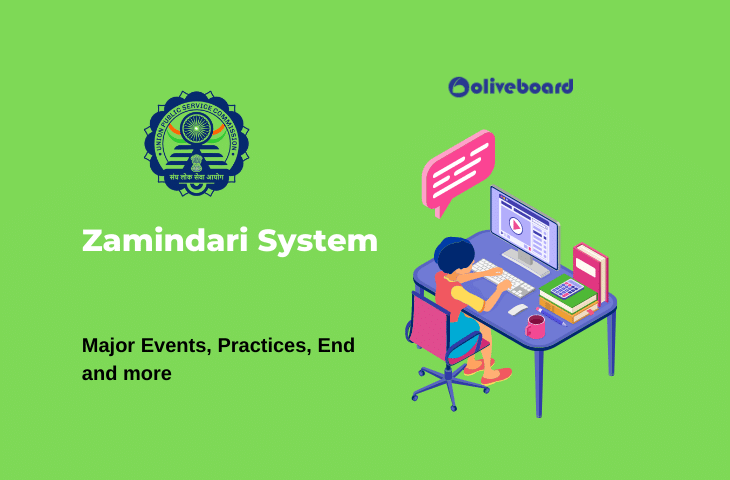Zamindari System (Permanent Land Revenue Settlement)
- Cornwallis introduced the Zamindari System in 1793 through the Permanent Settlement Act, and the British implemented it in the provinces of Bengal, Bihar, Orissa, and Varanasi.
- It is also known as the Permanent Settlement System.
- Zamindars were recognised as the landowners. Zamindars were given the authority to collect rent from peasants.
- While the zamindars became landowners, they made the actual farmers tenants.
- The tax was to be paid even if the yield was low, and it was to be paid in cash. Prior to the implementation of this system, the tax could be paid in kind.
- The total amount realised would be divided into 11 parts. Zamindars own one-tenth of the company, while East India Company owns ten-tenths of the company.
In British India, there are several different types of land revenue systems.
- Zamindari system
- Ryotwari system
- Mahalwari system
Indian cottage and agriculture industries were inextricably linked until the 18th century. India occupied a prominent position in the world’s handicraft and agriculture production. By establishing revolutionary land tenure structures and revenue administration practises, British colonial rulers devastated the handicraft sector while also generating far-reaching changes in the country’s agrarian structure.
- Permanent Settlement/ Zamindari System: During the British administration, the divisions of Bihar, Bengal, Banaras, and the NWFP amounted to around 19% of the total land.
- Ryotwari System: During British administration, the Assam, Bombay, and Madras Presidencies covered roughly 51% of the territory.
- Mahalwari System: During British administration, the Mahalwari System covered 30% of the country, including important areas of the NWFP, central provinces, and Punjab.
Lord Cornwallis’ Permanent Settlement Act established the Zamindari System. The Zamindari System had three key components: the British, Zamindars (Landlords), and peasants.
Major Events In The Zamindari System
The zamindars were recognised as landowners who leased their properties to tenant farmers in exchange for a share of the harvest. In turn, the Zamindar was required to pay a set amount to the British government. This resulted in widespread peasant exploitation.
From the first decade of the twentieth century, peasant issues were an important aspect of the liberation movement. The situation of the peasantry and their upliftment was one of the themes that the national movement focused on after 1915. As a result, the removal of intermediaries, and hence the zamindari system, became more important. During the early twentieth century, a number of significant events relating to land revenue reform occurred:
- The Champaran Satyagraha (1917) against forced indigo planting was Mahatma Gandhi’s first movement in India, and it was aimed at peasants.
- Kheda Satyagaraha (1918) protested exorbitant taxes in the aftermath of a plague epidemic and crop devastation.
- During the Bardoli Satyagraha in 1928, peasant issues were raised. Sardar Vallabbhai Patel raised the topic of a 30% tax increase shortly after a significant flood and subsequent crop loss.
- Apart from Gandhian activities, there were a number of peasant groups working for the rights of middle and lower-class peasants on their own. The ‘Awadh Kisan Sabha,’ led by Madari Pasi in the old United Provinces, was one such movement (present-day Uttar Pradesh).
- In addition, the Indian National Congress’s Karachi session of 1931 included agriculture and peasant issues in its list of Fundamental Rights and Economic Program.
- During the Faizpur Agrarian Programme in 1936, a reiteration of the demands expressed at the INC’s Karachi session in 1935 was made.
- The Kisan Conference in Allahabad in 1935, presided over by Sardar Patel, the Bihar Kisan Sabha by Swami Sahajanand Saraswati, and the Andhra Riyad Association by NG Ranga, passed a resolution calling for the abolition of the Zamindari system.
End Of The Zamindari System
Following independence, the zamindari system was legally abolished. Articles 19 and 31 of India’s Constitution were altered for the first time in 1951 with the first amendment. The right to property was changed to empower governments to enact legislation to abolish the zamindari system.
The liberation movement focused heavily on British India’s land revenue schemes. Immediate triggers to diverse agitations, as mentioned in the preceding paragraphs, in many circumstances. They should also look into the effects of land revenue regimes on the general public.
Conclusion
In British India, there are several different types of land revenue systems. We hope this article provides you with the relevant details about Zamindari System. For any queries, contact us at Oliveboard.
FREQUENTLY ASKED QUESTIONS
Under his Permanent Settlement Act, Lord Cornwallis, who was governor-general of India from 1786 to 1793, instituted the Zamindari System.
During British rule, land revenue systems were introduced, and intermediaries such as Zamindars, Mahal wars, and Ryotwars arose. These groups of individuals were causing problems for the cultivators. Therefore the decision was made to dismantle the Zamindari System.
The most important characteristics of the Zamindari System are:
The Zamindars were made the proprietors of the land and granted the power to collect rents from the peasants.
The rent or total amount collected by the Zamindar was divided into 11 parts, with 10/11 of the share going to the East India Company and only 1/11 going to the Zamindar.
The difference between the Zamindari System under British rule and the Mughal Era are:
Unlike the Zamindari System under the Permanent Settlement system, lands were not taken away from peasants unless and until they were paying the rents.
Hereditary was a legal rule in the Zamindari System of Mughal Rule.
- UPSC Calendar 2026 PDF Out, Check All Exam Dates & Notifications
- UPSC EPFO Salary 2025, Pay Scale, Job Profile, Check Here
- UPSC Form Filling Format 2025, Get Latest Form Format in Detail
- What if I fail UPSC Prelims, How to Tackle UPSC Failure
- 10 Alternatives for UPSC Aspirants, Check 10 Best Alternatives
